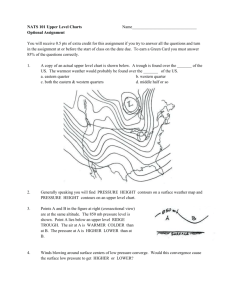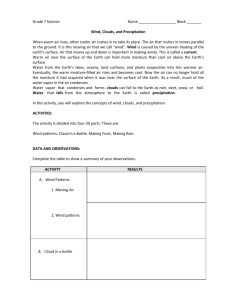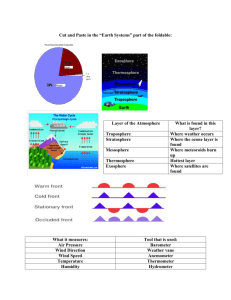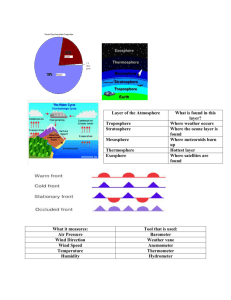How Weather Patterns Influence Bird Movements
advertisement
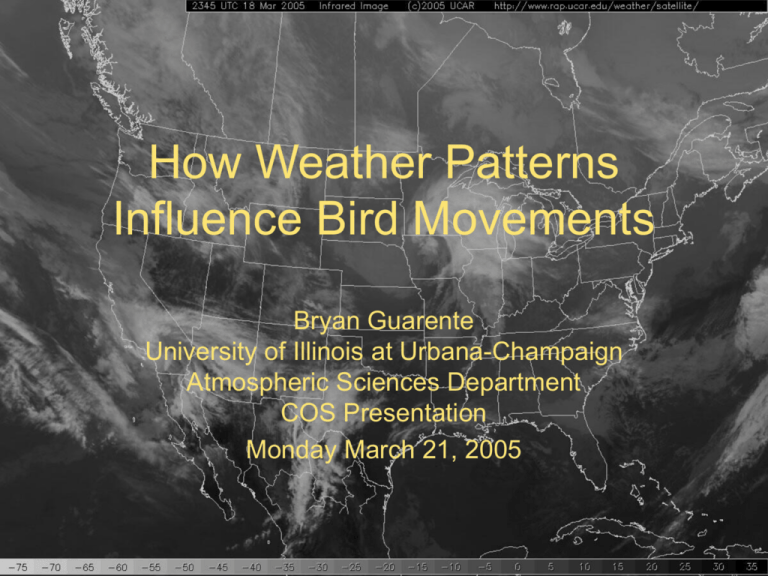
How Weather Patterns Influence Bird Movements Bryan Guarente University of Illinois at Urbana-Champaign Atmospheric Sciences Department COS Presentation Monday March 21, 2005 Outline • • • • • Bird Navigation How To Read Weather Maps Two Caveats Case Studies Helpful Resources Bird Navigation • How do birds migrate? – Using landmarks (Point Peleé) – “Staying within the lines” • Highways (I-95) • Ridges (Blue Ridge: Hawk Mountain) • Coastlines (Atlantic Coast, Lake Michigan) – Magnetism of the earth – Sun, Stars, Moon – “Believing their instincts” – Avoiding weather or go with weather Bird Navigation (cont) • Most important thing: – Which family of birds? – What habitat is needed? – What time of year? • “Circlers” (Soaring) – Falconiformes – Gruiformes • Direct Flights (short and long distance) – Anseriformes – Charadriiformes – Passeriformes Bird Navigation (cont) • “Circlers” – Thermals: pockets of warm rising air • Thermals enhance a good migration day for circlers • Strong upper level winds also make for a good “circler” migration day – Thermals are not required but circlers will limit distances on days without thermals Bird Navigation (cont) • Short Distance vs. Long Distance Migrants – Long migration is not effected greatly by weather patterns • More dependant on season or amount of sunlight • Examples: Arctic Tern, Sandpipers, and Barnacle Goose – Short migration is effected greatly by weather patterns • Less dependant on season or amount of sunlight • Examples: Most Passerines and Waterfowl Problems encountered • What would you do if you were flying and you encountered – Significant Cloud Coverage? – Frozen Precipitation? – Strong Winds opposing your motion? –Land! Birds experience these conditions and are forced to land all the time. How’s the weather up there? • Upper atmosphere makes all the difference – BIRDS DO NOT MIGRATE AT SURFACE • Surface winds seldom important – Between 1km and 5km AGL winds are the biggest weather factor • 850mb (1km) to 500mb (5km) most important levels for winds • However, surface weather systems effect upper atmosphere – Surface cannot be ignored How to read weather maps • Birds prefer to follow winds (cross country flight example) • Most maps show winds – wind barbs – All directions are the same as a compass – Plotted as the direction the wind is FROM How to read weather maps • Rotation of highs and lows visible on surface obs How to read weather maps • Convergence and divergence will show areas of preferential movement to and from a location • Multiple kinds of convergence and divergence (directional and speed) How to read weather maps • Areas of convergence and divergence visible How to read weather maps • Streamlines – Shows direction a bird would travel… without outside forcing – Can see where migrants will come from or end up – Easiest way to see convergence at any level – Fronts become obvious (lines of convergence) • Fronts make some birds stop migration (strong pressure decline, assume bad weather) – Uncommonly plotted… especially for forecasts How to read weather maps How to read weather maps • 850 mb (1km up) – BEST place to look for strong winds that will promote movements – Strong winds from preferential direction = GOOD MOVEMENTS • Season dependant – Stronger winds at this level are called “lowlevel jet” – The end of a low-level jet has speed convergence (great place to look for migrants) How to read weather maps How to read weather maps • 700mb (2-2.5km up) – Good place to look for strong winds for migrants – Not as good as 850mb, but still important – Low-level jet also present at this level – Stacked strong winds (700mb strong winds above 850mb strong winds) = GOOD MOVEMENT How to read weather maps How to read weather maps • 500mb (5-6km) and 250mb (10-12km) – Winds at these levels only effect high altitude fliers – Hard to track these birds – Track vertical motions • Upward vertical motion may lead to movement – Barring cloud cover (which accompanies rising motion) – Unproven, but feasible How to read weather maps How to read weather maps How to read weather maps • Jetstreaks and vertical motions – Jetstreaks: areas of fastest moving winds in jetstream – Dynamical effects cause divergence How to read weather maps • Jetstream convergence and divergence How to read weather maps How to read weather maps How to read weather maps • Infrared (IR) Satellite Imagery – Low pressure systems look like commas – High clouds versus low clouds – Figure out low level winds from low clouds (if present) – Sometimes see areas of preferred heating of the ground (areas good for circlers) – Nighttime cloud cover How to read weather maps • Visible Satellite Imagery – Low pressure systems look like commas – Cloud levels not clear in some cases – Visible satellite not available at night How to read weather maps How to read weather maps • Water Vapor (WV) Satellite Imagery – Low pressure systems sometimes look like commas – Rotations can be seen very clearly • Rotations are usually associated with vertical motion and bad weather (can ground birds) – Jetstream pattern is often clearly visible – Can infer streamlines – Images available at night – Cannot see below 700mb How to read weather maps • Radars – Radar Reflectivity • Two different modes used (for small particles and large particles) – Clear air mode – Precipitation mode • Clear air mode: – Easy to pick up fronts and smaller particles (clutter issues) – Precipitation cannot be present • Precipitation Mode – Hard to pick up fronts and smaller particles – Precipitation will be present – May be hard to distinguish birds from precipitation How to read weather maps Two Caveats?! • Good weather patterns do not always equal good migration • All weather forecasts are model produced – Models differ – Models are made using our current understanding of the atmosphere – Weather forecasts beyond three days are pipedreams • Because of this: models are NEVER correct! – BUT, we need to look for guidance somewhere Experience is the key • As it is with birds: – The more you look, the more you understand • This may not come easy for some of you • Every day forecasts change – Look often and be flexible Are you ready for your first try? What happened on this day? • Black-legged Kittiwake (Rissa tridactyla) showed up near Chicago (reported by Eric Walters) • Refer to emails on IBET (8077, 8078, 8082, 8087, 8091) for discussion of patterns • For sightings refer to IBET (8094 BLKI, 8096 BLKI, 8100 FEHA, 8101 SACR) What happened on this day? • Sandhill Cranes (Grus canadensis) “clouded” the Chicago area skies (1,269 reported by Matt Karabestos; 400 reported by Leslie Cummings) • First real push of Sandhill Cranes (G. canadensis) all season • IBET posts (9514 – 9518, 9521, 9526, 9528) Summary • Upper-level winds are the most important factor (weather-wise) – The longer time scale the better • Areas of convergence = runways • Surface fronts play a role but can be avoided by larger birds if they are weak fronts • Clouds, precipitation, and strong winds opposing motion will make a bird land Useful Resources • http://www.atmos.uiuc.edu/~bguaren2/ birdweather/index.html • http://www.rap.ucar.edu/weather • http://weather.cod.edu/ • http://vortex.plymouth.edu/ • http://www.crh.noaa.gov/ Other helpful sources • “Severe and Hazardous Weather” 2nd edition – Rauber, Charlevoix, and Walsh – Excellent introductory weather book – Written with non-science students in mind – Figures from today’s presentation from book Thank you! • • • • • COS IBET COS member: Tom Kelly Bruce D. Lee and Catherine Finley Albert Guarente (my dad)


